
 |
Tea Clipper |
 |
| from TeaAntiques.com | ||
| Edition Fifty Four |
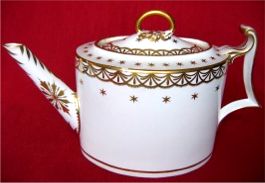
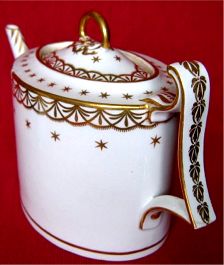
My antique for this month is a rare and beautifully elegant Derby teapot, dating from c1790. This delightful teapot is in very good condition too, which is also quite rare. The teapot is of a straight sided oval shape, with straight tapering spout, angular moulded handle and oval drop in lid with loop finial. The teapot is clearly marked on the base with the underglaze puce crown and cross baton mark, a mark used at the Derby factory c1782-1800. It also has the pattern number 466. This straight sided oval teapot with its neoclassical gilt decoration would date from c1790 and make a fine addition to a collector of Derby or eighteenth century porcelain.
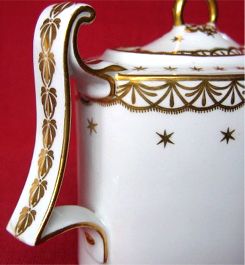
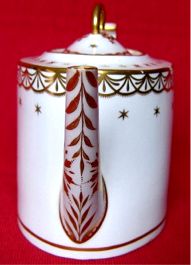
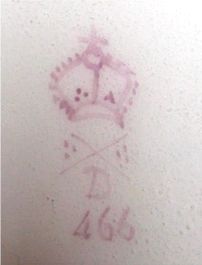
More details of this item and other tea related antiques can be found by visiting my web site at www.TeaAntiques.com.
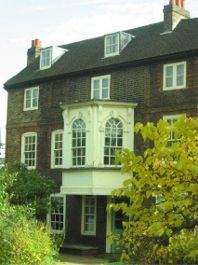 If
you are ever visiting Chiswick House in London, it is worth taking the 10 minute walk to Hogarth's House museum which is situated just outside of Chiswick House grounds
on the NE edge adjacent to the A4 road. It is this house that Hogarth, famous
for his illustrations of political and social life in the mid-eighteenth
century, spent the summer months or weekends between 1749 and his death in 1764.
Chiswick at this time was out in the rural countryside away from the heat and
pollution of the city of London. Much of the surrounding area was devoted to
small farms, supplying the city with fresh vegetables. When Hogarth came to this
house it was already two hundred years old and he made some alterations
extending it, also he changed it to including the addition of the bay window on
the first floor.
If
you are ever visiting Chiswick House in London, it is worth taking the 10 minute walk to Hogarth's House museum which is situated just outside of Chiswick House grounds
on the NE edge adjacent to the A4 road. It is this house that Hogarth, famous
for his illustrations of political and social life in the mid-eighteenth
century, spent the summer months or weekends between 1749 and his death in 1764.
Chiswick at this time was out in the rural countryside away from the heat and
pollution of the city of London. Much of the surrounding area was devoted to
small farms, supplying the city with fresh vegetables. When Hogarth came to this
house it was already two hundred years old and he made some alterations
extending it, also he changed it to including the addition of the bay window on
the first floor.
The house is now open to the public free of charge and contains information about Hogarth's life and his works. Many of the rooms contain sets of his satirical prints, such as 'Marriage À la mode', 'The Rake's Progress' etc. These finely engraved prints show humorous side of the life and times of some of the famous people of the time as well as social and political situations.
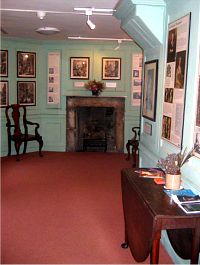 The
house may have been extended but is still rather a small house, having wood
panelled rooms, painted in typical period colour. There is a walled garden,
which has in it a Mulberry Tree, mentioned by Hogarth as a tree under which he
would sit and take tea.
The
house may have been extended but is still rather a small house, having wood
panelled rooms, painted in typical period colour. There is a walled garden,
which has in it a Mulberry Tree, mentioned by Hogarth as a tree under which he
would sit and take tea.
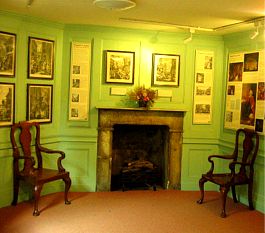 Entering
the house leads into a small hall with a tightly turning wooden staircase to the
first floor. To the left of the hall is one of the larger rooms, the dining
room. In this room are some modern chairs made to a typical design from the
early part of the eighteenth century. Display boards give the history of Hogarth
and his life. A small fireplace is situated at the far end of the dining room.
Originally, this room had been two rooms with a central front door, so the
alterations made a much larger room.
Entering
the house leads into a small hall with a tightly turning wooden staircase to the
first floor. To the left of the hall is one of the larger rooms, the dining
room. In this room are some modern chairs made to a typical design from the
early part of the eighteenth century. Display boards give the history of Hogarth
and his life. A small fireplace is situated at the far end of the dining room.
Originally, this room had been two rooms with a central front door, so the
alterations made a much larger room.
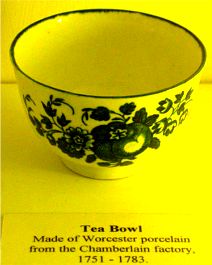 Progressing
upstairs to the first floor, to the right at the top of the stairs is the
principle bed chamber. Then to the left is the Parlour and beyond, the Study. In
the Parlour is the bay window; This type of window was fashionable at the time
and has been represented in Hogarth's prints, almost identical in design. It
would have been a most agreeable place in which to sit and look out over the
walled garden. There is a Parlour cupboard to the left of the fireplace, in
which are a few items from the time of Hogarth or slightly later. There is a
Worcester blue and white tea bowl, printed with fruits and dating from c1780.
Progressing
upstairs to the first floor, to the right at the top of the stairs is the
principle bed chamber. Then to the left is the Parlour and beyond, the Study. In
the Parlour is the bay window; This type of window was fashionable at the time
and has been represented in Hogarth's prints, almost identical in design. It
would have been a most agreeable place in which to sit and look out over the
walled garden. There is a Parlour cupboard to the left of the fireplace, in
which are a few items from the time of Hogarth or slightly later. There is a
Worcester blue and white tea bowl, printed with fruits and dating from c1780.
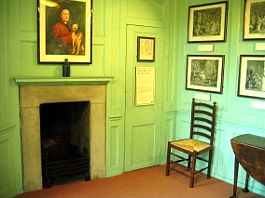
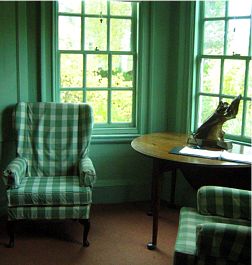
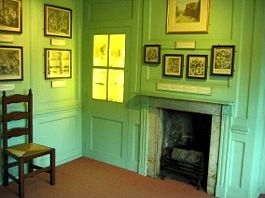
In the back Study, the room has an open fireplace at the far end. the walls display more of Hogarth's works, including a set of prints relating to the London theatre.
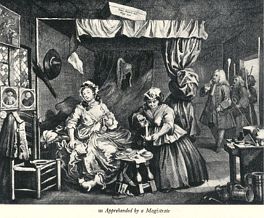
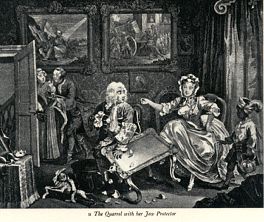
The delight for me in the works of Hogarth is the very fine detail that he
included. For example it is interesting to see that tea is included in several
of his works. In his set of pictures entitled 'A Harlot's Progress'
tea appears in two of the set of pictures.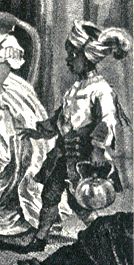 In 'The quarrel with her Jew
protector' the tea table at which they are sat is toppled over and the tea
equipage is seen falling to the ground, including a small globular teapot, tea
bowls and saucers which smash upon hitting the ground. It is also worth noting
that her small black page boy stands aghast to the right holding a silver tea
kettle with which he was preparing to top up the teapot.
In 'The quarrel with her Jew
protector' the tea table at which they are sat is toppled over and the tea
equipage is seen falling to the ground, including a small globular teapot, tea
bowls and saucers which smash upon hitting the ground. It is also worth noting
that her small black page boy stands aghast to the right holding a silver tea
kettle with which he was preparing to top up the teapot.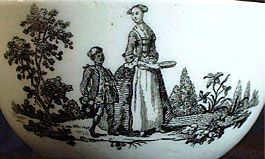 Hogarth often showed
black people in his prints as London was then quite cosmopolitan in its
population. Most of the time they were portrayed as liveried servants, prisoners
but occasionally as tradesmen. The black page in this print was later used on the
print used on Worcester tea wares - 'the tea party' print. In another of this
series of prints is 'Apprehended by a magistrate. Here a lady is pouring a jug
of hot water into the teapot ready for tea. On a stout four legged table is a
tea bowl and saucer as well as some simple foods.
Hogarth often showed
black people in his prints as London was then quite cosmopolitan in its
population. Most of the time they were portrayed as liveried servants, prisoners
but occasionally as tradesmen. The black page in this print was later used on the
print used on Worcester tea wares - 'the tea party' print. In another of this
series of prints is 'Apprehended by a magistrate. Here a lady is pouring a jug
of hot water into the teapot ready for tea. On a stout four legged table is a
tea bowl and saucer as well as some simple foods.
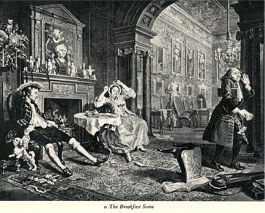
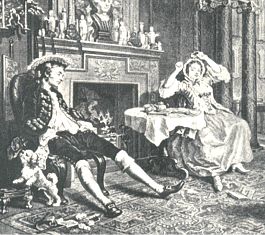
In the series of prints 'Marriage À la Mode' the tea theme once again appears. In the 'Breakfast scene' the young married couple are seen at a beautiful tripod tea table, this covered with a white table cloth on which sits tea. Note that the teapot sits upon a stand thus preventing damage to the surface of the wooden table. as well as a small tea bowl and saucer, there appears to be a larger bowl, either for slops or sugar. It is quite amazing the detail that Hogarth put into his illustrations on life and well worth studying in detail.
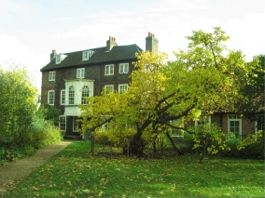
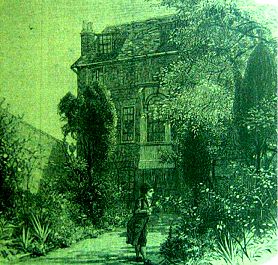
In the garden, the Mulberry tree is still standing - just! It is now so old that it has decided that it is time to lean over and rest and has the help of wooden props to hold it up. It is easy to imagine Hogarth and his wife relaxing under the shade of this tree in the hot summer months enjoying the delights of tea.
Hogarth's HouseClick here for
Local Map
Map courtesy of www.streetmap.co.uk
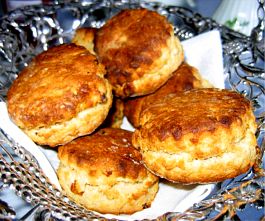
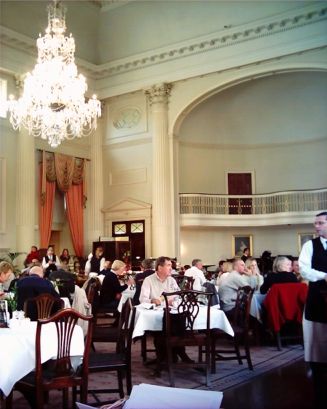 I
recently had an enjoyable afternoon tea in the Pump Room, Bath. Instead of
having the usual afternoon tea with sandwiches, plain scones, jam and cream
followed by cakes, I decided to try their apricot and honey scones. This is a
scone combination that I have never had the pleasure of sampling before. In the
Pump Room, they served them warm with butter and I can certainly say that they
were absolutely delicious.
I
recently had an enjoyable afternoon tea in the Pump Room, Bath. Instead of
having the usual afternoon tea with sandwiches, plain scones, jam and cream
followed by cakes, I decided to try their apricot and honey scones. This is a
scone combination that I have never had the pleasure of sampling before. In the
Pump Room, they served them warm with butter and I can certainly say that they
were absolutely delicious.
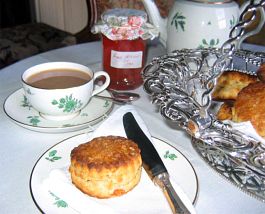 Maybe
some of my readers too have been fortunate enough to visit the Pump Room in Bath
and sample these excellent scones. However, for those who have not, I have
experimented at home and come up with a recipe of my own that works well too. I
have included the recipe at the bottom of this article and I hope that you find
time to try them for yourself.
Maybe
some of my readers too have been fortunate enough to visit the Pump Room in Bath
and sample these excellent scones. However, for those who have not, I have
experimented at home and come up with a recipe of my own that works well too. I
have included the recipe at the bottom of this article and I hope that you find
time to try them for yourself.
These scones are best served warm from the oven and I found them particularly nice split and spread with fine quality apricot jam. I did not think they were in need of cream as well, but that is entirely your choice and I am sure that they will still be delicious topped with a thick rich cream.
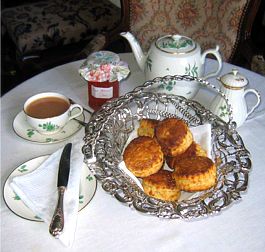
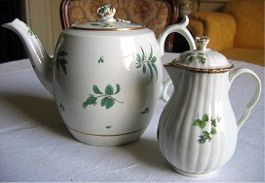
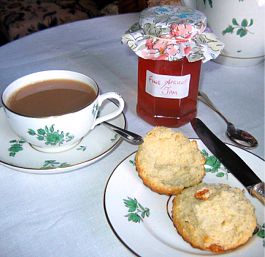
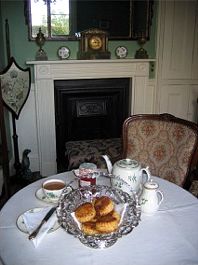 For
my afternoon tea setting, for those interested in the porcelain, it is an
interesting mix of eighteenth century Worcester and a later twentieth century
copy of the same design by the Worcester factory. The antique pieces from the
eighteenth century are the barrel shaped teapot and the covered fluted milk jug.
Each of these is decorated with simple green flower sprigs and their covers are
surmounted by moulded flower finials, creating an elegant, and I think charming
combination. These two items date from c1760. The milk jug has a vertically
fluted body and ear shaped handle, whereas the teapot has a plain barrel shaped
body with simple loop handle with a thumb piece on the top edge to aid holding
the teapot when full. The other pieces on the table,
which include the tea cup, saucer and tea plate are an edition made by the
Worcester factory, copying their design of the eighteenth century, likewise
decorated with the
same green floral sprigs. It should however be pointed out that in the
eighteenth century, there would not have been tea plates to the tea service. Tea
plates were a nineteenth century invention when teas became more elaborate, with
finger sandwiches, scones and cakes being served. In the mid-eighteenth century
when the teapot and milk jug were made, tea would only have comprised bread and
butter and a simple plain cake, each served from a large circular plate.
For
my afternoon tea setting, for those interested in the porcelain, it is an
interesting mix of eighteenth century Worcester and a later twentieth century
copy of the same design by the Worcester factory. The antique pieces from the
eighteenth century are the barrel shaped teapot and the covered fluted milk jug.
Each of these is decorated with simple green flower sprigs and their covers are
surmounted by moulded flower finials, creating an elegant, and I think charming
combination. These two items date from c1760. The milk jug has a vertically
fluted body and ear shaped handle, whereas the teapot has a plain barrel shaped
body with simple loop handle with a thumb piece on the top edge to aid holding
the teapot when full. The other pieces on the table,
which include the tea cup, saucer and tea plate are an edition made by the
Worcester factory, copying their design of the eighteenth century, likewise
decorated with the
same green floral sprigs. It should however be pointed out that in the
eighteenth century, there would not have been tea plates to the tea service. Tea
plates were a nineteenth century invention when teas became more elaborate, with
finger sandwiches, scones and cakes being served. In the mid-eighteenth century
when the teapot and milk jug were made, tea would only have comprised bread and
butter and a simple plain cake, each served from a large circular plate.
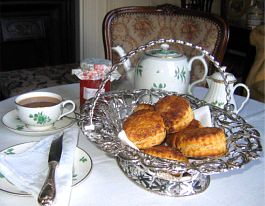 The
silver cake basket in which the scones are served, is a basket made by Richard
Mills in London in 1768, and is a very fine example of filigree work. Note the
open wire work basket shape over laid with scrolling fruit, flowers and ears of
corn. There are rococo 'C' scrolls round the border of the basket and an
entwined loop swing handle. The perfect way I think to serve
these home-made scones. There are some very fine cake baskets available on the
website, should you feel like you would like to indulge in a touch of elegance
at your afternoon tea table.
The
silver cake basket in which the scones are served, is a basket made by Richard
Mills in London in 1768, and is a very fine example of filigree work. Note the
open wire work basket shape over laid with scrolling fruit, flowers and ears of
corn. There are rococo 'C' scrolls round the border of the basket and an
entwined loop swing handle. The perfect way I think to serve
these home-made scones. There are some very fine cake baskets available on the
website, should you feel like you would like to indulge in a touch of elegance
at your afternoon tea table.
My own recipe for the apricot and honey scones is as follows.
Apricot and Honey Scones
Method:
Preheat the oven to Gas Mark 4 (220ºC, 425ºF)
Sift the flour and salt into a mixing bowl. Add the butter and rub into the flour using your hands until the mixture resembles fine bread crumbs. Add the honey and mix it into the mixture with a knife. Sprinkle in the chopped apricots and mix them into the mixture. Add the beaten egg and mix it in. Then add just enough milk to make a stiff dough of the mixture. Knead it lightly into a ball and turn it out onto a lightly floured board. Roll the dough out to about ¾" thick and use a 2-2½" pastry cutter to cut out the scones. Place the scones on a flat baking tray and place them into the middle of a hot oven. Cook for approximately 10 - 12 minutes, or until risen and golden brown on the outside.
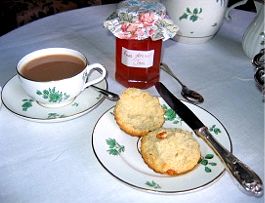 Best
served whilst still warm, split in half with butter and apricot jam on them. I
hope that you enjoy them as much as I do.
Best
served whilst still warm, split in half with butter and apricot jam on them. I
hope that you enjoy them as much as I do.
To review past newsletters, just follow this link:
Past newsletters.
To subscribe to this free newsletter -
Click here